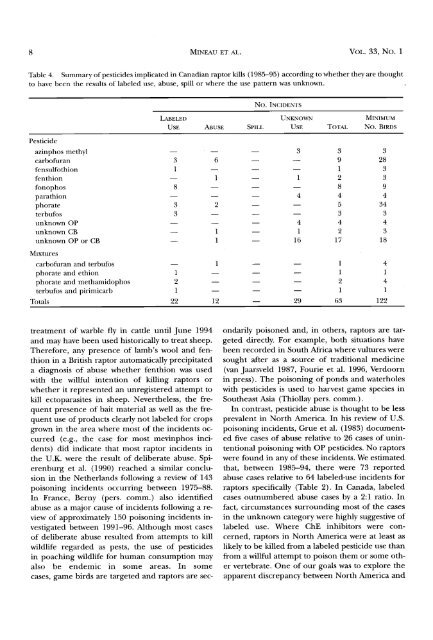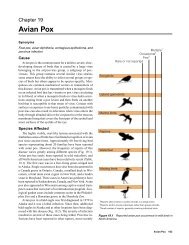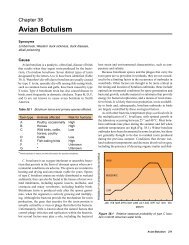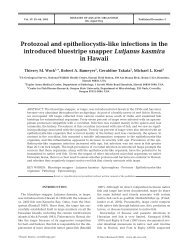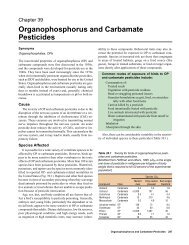poisoning of raptors with organophosphorus and carbamate ...
poisoning of raptors with organophosphorus and carbamate ...
poisoning of raptors with organophosphorus and carbamate ...
Create successful ePaper yourself
Turn your PDF publications into a flip-book with our unique Google optimized e-Paper software.
8 M•NE^V ET AL. VOL. 33, No. 1<br />
Table 4. Summary <strong>of</strong> pesticides implicated in Canadian raptor kills (1985-95) according to whether they are thought<br />
to have been the results <strong>of</strong> labeled use, abuse, spill or where the use pattern was unknown.<br />
No.<br />
INCIDENTS<br />
Pesticide<br />
LABELED UNKNOWN MINIMUM<br />
USE ABUSE SPILL USE TOTAL NO. BIRDS<br />
azinphos methyl -- -- -- 3 3 3<br />
carb<strong>of</strong>uran 3 6 -- -- 9 28<br />
fensulfothion 1 -- -- -- 1 3<br />
fenthion -- 1 -- 1 2 3<br />
fonophos 8 -- -- -- 8 9<br />
parathion -- -- -- 4 4 4<br />
phorate 3 2 -- -- 5 34<br />
terbufos 3 -- -- -- 3 3<br />
unknown OP -- -- -- 4 4 4<br />
unknown CB -- 1 -- 1 2 3<br />
unknown OP or CB -- 1 -- 16 17 18<br />
Mixtures<br />
carb<strong>of</strong>uran <strong>and</strong> terbufos -- 1 -- -- 1 4<br />
phorate <strong>and</strong> ethion 1 -- -- -- 1 1<br />
phorate <strong>and</strong> methamidophos 2 -- -- -- 2 4<br />
terbufos <strong>and</strong> pirimicarb 1 -- -- -- 1 1<br />
Totals 22 12 -- 29 63 122<br />
treatment <strong>of</strong> warble fly in cattle until June 1994<br />
<strong>and</strong> may have been used historically to treat sheep.<br />
Therefore, any presence <strong>of</strong> lamb's wool <strong>and</strong> fenthion<br />
in a British raptor automatically precipitated<br />
a diagnosis <strong>of</strong> abuse whether fenthion was used<br />
<strong>with</strong> the willful intention <strong>of</strong> killing <strong>raptors</strong> or<br />
whether it represented an unregistered attempt to<br />
kill ectoparasites in sheep. Nevertheless, the frequent<br />
presence <strong>of</strong> bait material as well as the frequent<br />
use <strong>of</strong> products clearly not labeled for crops<br />
grown in the area where most <strong>of</strong> the incidents occurred<br />
(e.g., the case for most mevinphos incidents)<br />
did indicate that most raptor incidents in<br />
the U.K. were the result <strong>of</strong> deliberate abuse. Spierenburg<br />
et al. (1990) reached a similar conclusion<br />
in the Netherl<strong>and</strong>s following a review <strong>of</strong> 143<br />
<strong>poisoning</strong> incidents occurring between 1975-88.<br />
In France, Berny (pers. comm.) also identified<br />
abuse as a major cause <strong>of</strong> incidents following a review<br />
<strong>of</strong> approximately 150 <strong>poisoning</strong> incidents investigated<br />
between 1991-96. Although most cases<br />
<strong>of</strong> deliberate abuse resulted from attempts to kill<br />
wildlife regarded as pests, the use <strong>of</strong> pesticides<br />
in poaching wildlife for human consumption may<br />
also be endemic in some areas. In some<br />
cases, game birds are targeted <strong>and</strong> <strong>raptors</strong> are sec-<br />
ondarily poisoned <strong>and</strong>, in others, <strong>raptors</strong> are targeted<br />
directly. For example, both situations have<br />
been recorded in South Africa where vultures were<br />
sought after as a source <strong>of</strong> traditional medicine<br />
(van Jaarsveld 1987, Fourie et al. 1996, Verdoorn<br />
in press). The <strong>poisoning</strong> <strong>of</strong> ponds <strong>and</strong> waterholes<br />
<strong>with</strong> pesticides is used to harvest game species in<br />
Southeast Asia (Thiollay pers. comm.).<br />
In contrast, pesticide abuse is thought to be less<br />
prevalent in North America. In his review <strong>of</strong> U.S.<br />
<strong>poisoning</strong> incidents, Grue et al. (1983) document-<br />
ed five cases <strong>of</strong> abuse relative to 26 cases <strong>of</strong> unin-<br />
tentional <strong>poisoning</strong> <strong>with</strong> OP pesticides. No <strong>raptors</strong><br />
were found in any <strong>of</strong> these incidents. We estimated<br />
that, between 1985-94, there were 73 reported<br />
abuse cases relative to 64 labeled-use incidents for<br />
<strong>raptors</strong> specifically (Table 2). In Canada, labeled<br />
cases outnumbered abuse cases by a 2:1 ratio. In<br />
fact, circumstances surrounding most <strong>of</strong> the cases<br />
in the unknown category were highly suggestive <strong>of</strong><br />
labeled use. Where ChE inhibitors were con-<br />
cerned, <strong>raptors</strong> in North America were at least as<br />
likely to be killed from a labeled pesticide use than<br />
from a willful attempt to poison them or some other<br />
vertebrate. One <strong>of</strong> our goals was to explore the<br />
apparent discrepancy between North America <strong>and</strong>


